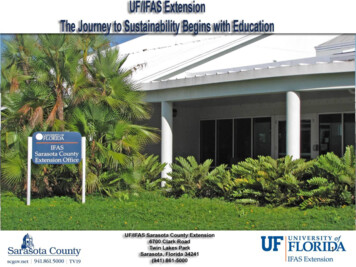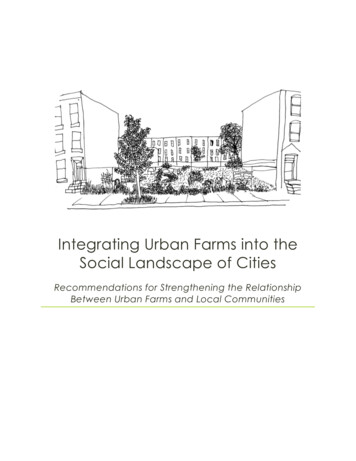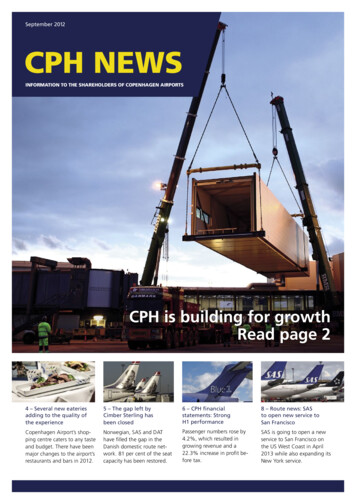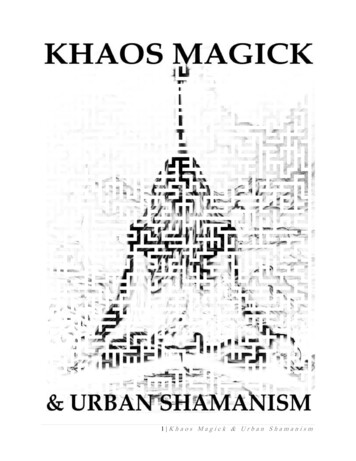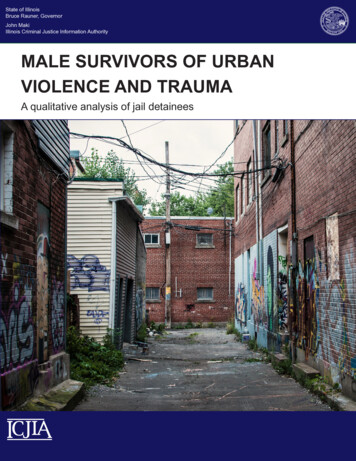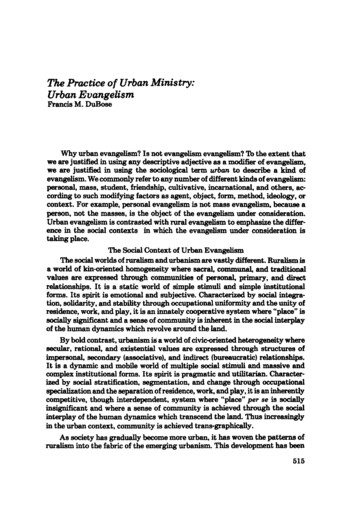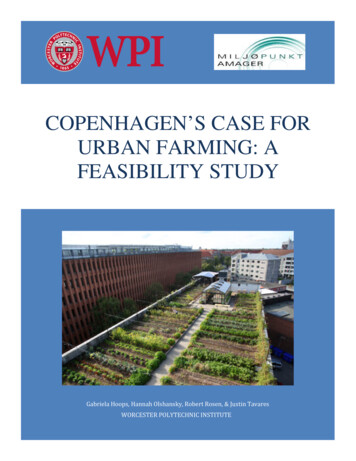
Transcription
COPENHAGEN’S CASE FORURBAN FARMING: AFEASIBILITY STUDYGabriela Hoops, Hannah Olshansky, Robert Rosen, & Justin TavaresWORCESTER POLYTECHNIC INSTITUTE
Copenhagen’s Case for Urban Farming: AFeasibility StudyAn Interactive Qualifying Project (IQP)Submitted to the Faculty of:WORCESTER POLYTECHNIC INSTITUTEIn Partial Fulfillment of the Requirement for theDegree of Bachelor of ScienceSubmitted By:Gabriela HoopsHannah OlshanskyRobert RosenJustin TavaresApril 30, 2018Submitted to:Project Advisors:Holly AultConstance ClarkProject Sponsor:Claus Knudsen, Center LeaderThis paper represents the work of WPI undergraduate students in completion of a Bachelor ofScience degree requirement. WPI routinely publishes these reports on their website without editor peer review.i
AbstractCopenhagen seeks to be carbon neutral by 2025. Miljøpunkt Amager, a Copenhagenenvironmental organization, was curious about urban farming’s potential to furtherenvironmentalism in Amager. Our project examined the environmental, social, political,economic, civic, and public health implications of urban agriculture in order to identify therequirements for the realization of urban farms in the region. We analyzed the costs of an urbanfarm in order to create economic models of potential farm implementations. Through researchand interviews, we were able to assess the potential of urban farming within Amager and providerecommendations to further promote urban agriculture in the community.i
AcknowledgementsOur group would like to thank these individuals and organizations for all of the time and effortthey have provided us during the completion of our project.Our sponsor Miljøpunkt Amager:Claus KnudsenHodan OsmanLisa ArreMaja GuldagerLotte KristensenInge HoppsMonika MostThank you so much for welcoming us into your organization and providing so muchhelpful advice and guidance. We have loved working with you and we cannot thank youenough.Our WPI advisors and staff that aided us for fourteen weeks:Seth TulerHolly AultConstance ClarkPaige NeumannOur school that gave us the opportunity to work on the project:Worcester Polytechnic Instituteii
Executive SummaryWhy Investigate Urban Farming?Global warming is an international crisis. Agriculture accounts for 12% of greenhouse gas(GHG) emissions annually (Linquist et al., 2012). As such, alternate agricultural practices suchas urban farming will play a large role in the global pursuit of environmental sustainability. In2005, the city of Copenhagen adopted the Copenhagen Climate Plan. The plan established theambitious goal of becoming a carbon neutral municipality by 2025. In order to achieve this goal,Copenhagen must eliminate an estimated 1.2 tons of greenhouse gas emissions annually (Dahal& Niemelä, 2017). One avenue to decrease GHG production is urban farming. Urban farms,agricultural ventures located within metropolitan areas, are currently excluded from theCopenhagen Climate Plan (Greensgrow Farms, 2018; City of Copenhagen Technical andEnvironmental Administration, 2009). Consequently, their potential for assisting in urbanenvironmentalism is largely untapped.Our project examined the many economic, social, political and environmental implications ofurban agriculture within Amager. Through this examination, we sought to identify strategies formarket identification, facility acquisition, crop selection, farm operation, community outreachand the many other tasks necessary for the realization of urban farms. By investigating thevarious components, we were able to identify the minimum requirements for the creation ofurban farms within Amager and provide Miljøpunkt Amager with recommendations to helppromote the establishment of urban farming initiatives.How to Investigate Urban Farming?In order to complete this comprehensive assessment of urban farming in Amager, we identifiedfive objectives that necessitated investigation:1. Identifying potential markets and feasible business models to create an economicallysustainable urban farm.2. Assessing the economic viability of urban farming initiatives within Amager.3. Determining criteria for a feasible urban farm including location, farm operation, cropselection, and labor structure.4. Analyzing the impact of local regulations on potential urban farming initiatives.5. Identifying organizations and individuals that would engage with urban farming projects.In order to satisfy these objectives, we completed an initial literature review to understand all ofthe components of urban farming projects. We then built upon this research by identifying overone hundred urban farms and examining the information on their websites. This online researchprovided insight into urban farms on a global scale. Additionally, we investigated the pricepoints of urban farm components within Copenhagen. We also delved into other logisticalconcerns such as the details of local regulations and local climate as well as potential avenues forfunding an urban farm through grant programs.iii
Onsite in Copenhagen, we conducted interviews with representatives of pre-existing urbanfarms, restaurant owners, and leaders of social organizations. Additionally, we contacted urbanfarms globally and conducted email interviews to obtain a more comprehensive perspective onurban farming. Our research allowed us to gain multiple perspectives in order to fullycomprehend all aspects of urban farming initiatives.What Have We Found?After investigating the many facets of urban farming, we were able to gain insight into theeconomics, logistics, and social implications of urban farming projects within Amager. Ourgroup analyzed the many revenue streams and costs associated with urban farms. In addition, weexamined the logistics of creating an urban farm including the legal process, locationidentification, physical infrastructure and crop selection. The team also investigated the socialcomponent by pinpointing the ways that community members interface with urban farming andby exploring the potential for urban farming to advance social causes within the community.Economically, we found that urban farms utilize a combination of revenue streams thatinclude CSAs, farm stands, and restaurants. Our group noticed this trend when examiningthe economic strategies of urban farms globally. In these investigations, we also found thaturban farms use organizational profits, private funding, and grants to cover the startupand initial operation costs of urban farms; these costs are primarily dictated by thevariable size and infrastructure of the farm.Logistically, we examined the issues of regulations, location, infrastructure, and crop selectionon urban farms. On the regulatory side, it became evident that because these initiatives arerelatively new within Copenhagen, many regulations are undefined, causing a challenginglegal process. Operations on rooftops also result in specific challenges. Due to a lack ofundeveloped space, rooftops provide the most potential for urban farms within Amager;however, these rooftops must meet extensive specifications. Rooftop farms in Copenhagenrequire more than just specified regulations including reinforcements, elevators, and fencing. Inaddition, due to climate barriers, urban farms in Amager will likely require greenhouses inaddition to traditional outdoor irrigation and growing setups to grow theirproduce. Greenhouses are necessary because they extend the growing season and protectdelicate crops from the cold climate of Copenhagen. Although some crops are hardy enough togrow outdoors in the Copenhagen weather, these hardy crops are often not the most profitableoptions. In the crop selection process, urban farms must take into account climate,resource availability, and yield; however, the most important factor is often marketdemand.Lastly, we found that urban farms often combine social missions with profitable businessmodels in order to involve the surrounding community. One frequent opportunity for thiscommunity involvement can be found in the farm labor. Although most urban farms have asmall number of permanent employees, the majority of the physical labor is often done byvolunteers or participants in social welfare programs. Volunteer work allows urban farms toiv
interact with their community and to add value to their enterprise. Not only are they aneconomically sustainable environmental initiative, but they are able to incorporate socialmissions as well.As an extension of our research, we developed case studies that outline the basic logistical andfinancial considerations involved with starting an urban farming business. In conducting thesecase studies, we primarily focused on four main variables: revenue streams, subsidized rent,volunteer labor, and greenhouses. In varying revenue streams, we created economic models fora CSA, farmer’s market, and restaurant collaboration, and modeled farms with differentcombinations of these three revenue streams. Because we observed that many farms negotiatedfor negligible rent, we also compared farm profitability when paying rent compared to when rentis subsidized. Similarly, we observed the effect of eliminating paid labor in favor of freevolunteer labor on farm success. Lastly, we examined farms that increase production viaextending the growing season with greenhouses versus farms that lack greenhouses and onlyhave sheds to store tools. By varying these components, we are able to demonstrate a range ofeconomic situations for a 500 square meter rooftop farm in Amager. The four cases weexamined can be seen in Table 1.Table 1: Case DescriptionsSubsidizedRentCase 1 Case 2Case 3Case 4GreenhouseCSA Farmer’sMarket Restaurant VolunteerLabor In examining the projections for each of these cases, we observed that Case 1 is successful andbreaks even during the fourth year of operation, making 260.000 kr. over five years (Figure 1).We anticipated this result as Case 1 represents the ideal scenario for urban farm creation. Inreality, it is unlikely an urban farm will be created in this optimal scenario. Consequently, wecreated Cases 2, 3, and 4 in order to model a farm that is both economically viable and realistic.Case 2 loses approximately 2,1 M kr. by year five. Similarly, Case 3 also loses money; however,it reduces the deficit seen in Case 2 by 1,3 M kr. The only difference between these twoscenarios is that Case 2 uses a farm stand while Case 3 uses a CSA. This comparison shows thatCSA is a more profitable strategy than a farmer’s market. Because both Case 2 and 3 result in adeficit, the farm model requires adjustment in order to become profitable. By assuming allphysical labor is performed by volunteers, we obtain Case 4 which demonstrates a successfulmodel. Case 4 breaks even in year five and makes 270.000 kr. over the first five years. Thus,Case 4, a 500 square meter farm with volunteer labor and a CSA, provides an example of aneconomically and logistically viable urban farming initiative within Amager.v
Figure 1: Net IncomeWhat is the Next Step for Urban Farming in Amager?After examining all of these facets of urban farming initiatives, we identified three overarchingrecommendations to promote urban farming within the Amager community.1. Continue to research the logistics of urban farming.2. Streamline the process of establishing an urban farm by creating municipal supportinitiatives.3. Network with individuals, businesses, and social organizations within the AmagerCommunity.Continue to Research the Logistics of Urban FarmingOver the course of this project, we have conducted extensive research into the components ofurban farms; however, there is room for further inquiry. Specifically, prospective urbanfarmers should further investigate farm revenue streams, crop selection, and farminfrastructure. Although we observed different examples of CSA, farm stands, and restaurantcollaborations, our research did not extend to analyzing the different methods of executing eachof these profit strategies to maximize profits. Consequently, we recommend that organizationslooking to promote urban farming, such as Miljøpunkt Amager or prospective urban farmers,conduct further research into the optimal methods of implementing each revenue strategy. Thisresearch would identify the most profitable and easiest methods of selling produce using each ofthese profit models.In terms of crop selection, identifying the benefits and drawbacks of specific crops provedoutside of our scope. Our group believes the next step is conducting market research to single outthe crops in high demand in the Copenhagen market. In addition, this research could bevi
expanded to analyze these crops in terms of yield and market value. This research would allowurban farming projects to identify the most profitable crops in Copenhagen’s specific market.Similarly, we were able to identify the need for greenhouses, but looking at the advantages anddisadvantages of specific greenhouse structures was outside of our focus. Identifying the mosteconomical and environmentally friendly greenhouse options would be a productive continuationof this research.Streamline the Process of Establishing an Urban Farm by Creating MunicipalSupport InitiativesThe municipality of Amager could help to facilitate urban farming projects within thecommunity. First, the municipality could assist in the identification of potential urban farmlocations. The district could conduct a survey of rooftops to identify those already equipped forurban farms. In our research, we were able to identify many of the attributes required of arooftop in order to make it a viable candidate for an urban farm. The next step is to apply thesequalifications to rooftops within Amager in order to identify optimal locations for urban farms.Another strategy that could be used to promote urban farming is providing incentives to buildingowners that host farms on their roofs. In our research, we found that many rooftop urban farmersnegotiate with building owners for extremely low or nonexistent rent payments. Themunicipality could encourage these agreements by providing tax or utility breaks to buildingowners that host urban farms. Lastly, in order simplify legal process involved with establishinga farm, we recommend compiling a document detailing all of the regulations that apply torooftop urban farming projects. A compiled document would allow for more standardizedexpectations between regulatory bureaus and the prospective farmers. This list would streamlinethe legal process associated with creating urban farms.Establish networks between individuals, businesses, and social organizationswithin the Amager CommunityWe recommend that Miljøpunkt Amager pursue community outreach to establishconnections with individual citizens, potential economic partners, and socialorganizations. Our research demonstrated that individual citizens are important contributors tourban farming initiatives. As a result, we recommend reaching out to the local residents in orderto gain support for these initiatives, as well as getting individuals involved in the process ofestablishing and running urban farms. Gaining support could be achieved through publicprogramming, social media outreach, marketing campaigns, or in-person conversations.Networking with companies and organizations also provides potential for economicpartnerships. Many companies have programs to promote sustainability and community service.It would be beneficial to Miljopunkt and similar advocacy organizations to interact withcompanies and organizations that would be interested in funding or sponsoring new urbanfarming initiatives. In addition, Miljøpunkt Amager should continue to network with socialwelfare organizations. Not only does urban farming have the potential to be an environmentalboon to the community, but it can also be integrated into social welfare programs. Interfacingwith social welfare programs often provides a labor force for the farm while adding value to thecommunity.vii
In creating these recommendations, we helped Miljøpunkt Amager promote urban farminginitiatives in their region. Over the course of this project, we were able to gain comprehensiveinsight into the impacts and requirements of urban farming. This insight helped us craft ourrecommendations for furthering urban farming in Amager. In addition, our understanding ofurban farming practices allowed us to create economic models of potential implementations forurban farms in this community. The projections of these models clearly show that creating alogistically and economically feasible urban farm in Amager is an achievable goal. Therefore, inthis examination of urban farming, we have demonstrated that urban farming is a feasibleenterprise in the Amager community.viii
AuthorshipGabriela Hoops:Gabriela’s main contributions were within research and graphic design. She took the lead oncreating the posters and created presentations for the group. Aside from this Gabriela helpedresearching for the deliverables, conduct interviews, edit the paper, and participate in all generalteam activities and discussions.Hannah Olshansky:Hannah’s main contributions were within the writing and editing of the paper. She took the leadon drafting and editing all sections. Outside of writing, Hannah helped to contact urban farms,conduct interviews, present, and participate in all general team activities and discussions.Robert Rosen:Robert’s main contributions were being the main data researcher for most of the sections of thepaper, case studies, and main deliverables. These topics contain but are not limited to croprequirements, farm revenue streams and projections, and contacting our urban farms. Outside ofdata researching, Robert helped edit the paper, conduct interviews, and participate in all generalteam activities and discussions.Justin Tavares:Justin’s main contributions were being the primary writer and editor of the case studies reportand conducting research for the paper. In addition, he was the primary author of the socialimpacts section of the background, organizational engagement sections of the methodology, andthe location prerequisites and farm infrastructure sections of the findings chapter. He was alsothe primary author of most progress reports, contacted restaurants to interview, and participatedin all general team activities and discussions.ix
Table of ContentsCopenhagen’s Case for Urban Farming: A Feasibility Study . iAcknowledgements . iiExecutive Summary . iiiAuthorship. ixTable of Contents . xList of Figures . xiiList of Tables . xiii1Introduction . 12Background . 32.1Copenhagen as a Frontrunner in Urban Environmentalism . 32.2Impacts of an Urban Farming Project . 32.2.1Environmental Impacts . 52.2.2Economic Impacts . 52.2.3Social Impacts . 62.2.4Civic Impacts . 72.2.5Public Health Impacts . 72.3 Best Practices for Design and Operation of Urban Farms . 82.3.1Farm Infrastructure . 82.3.2Business Models for Urban Farming . 102.43Summary . 10Methodology . 123.1.1 Interview Procedure . 143.1.2 Identify Potential Markets and Feasible Business Models to Create an EconomicallySustainable Urban Farm . 143.1.3 Assessing the Economic Viability of Urban Farming Initiatives within Amager . 143.1.4 Determining criteria for a feasible urban farm including location, farm operation, cropselection, and labor structure . 153.1.5 Analyzing the Impact of Local Regulations on Potential Urban Farming Initiatives. 163.1.6 Identify Organizations and Individuals that would Engage with Urban FarmingProjects . 163.2 Summary . 174.0 Findings and Analysis . 18x
4.1 Revenue Streams . 194.2 Farm Financials . 204.3 Crop Selection. 224.4 Regulations . 234.5 Labor Structure . 244.6 Community Engagement . 254.7 Farm Location Prerequisites . 254.8 Farm Infrastructure . 305.0 Case Studies . 325.2 Model Development. 325.2.1Business Models . 325.2.2Crop Selection. 335.2.3Startup Costs . 335.2.4Operation Costs . 345.3 Results . 356.0 Conclusions and Recommendations . 37References . 41Appendix A: Urban Farm Contact List . 48Appendix B: Copenhagen/Denmark Organizations Contact List . 52Appendix C: Simon Hansen Interview . 53Appendix D: Emil Stroh Interview . 57Appendix E: Michael/Kristian Skaarup Interview . 59Appendix F: Chris Chimenti Interview Transcript . 62Appendix G: Joah Pinje Interview Transcript . 67Appendix H: Kenneth Ellegaard Interview Transcript . 71Appendix I: Johanna Lundell Interview Summary . 74Appendix J: Why Urban Farming Poster . 75Appendix K: Urban Farming for Amager Poster . 76Appendix L: Revenue Stream and Greenhouse Data Totals . 77xi
List of FiguresFigure 1: Net Income . viFigure 2: ØsterGro (ØsterGro, n.d.). 8Figure 3: Noma Rooftop Greenhouses . 9Figure 4: Sundholm Urban Gardens . 9Figure 5: Farm Revenue Streams . 19Figure 6: Copenhagen Projected Population Growth (Københavns Kommune, 2015) . 26Figure 7: Focused Urban Development Areas in Copenhagen (Københavns Kommune, 2014) . 27Figure 8: Government Protected Green Areas in Copenhagen (Københavns Kommune, 2014) . 27Figure 9: Sunlight Analysis of Amager rooftops (Københavns Kommune, n.d.) . 29Figure 10: Net Income . 36xii
List of TablesTable 1: Case Descriptions . vTable 2: Impacts of Urban Farming . 4Table 3: Research Methods Breakdown . 13Table 4: Startup Expense Items . 21Table 5: Grants Available in Denmark . 22Table 6: Sample Crop Requirements . 23Table 7: Copenhagen Average Monthly Sunlight (ClimaTemps Online Database, n.d.). 30Table 8: Copenhagen Average Monthly Temperature & Rainfall (Climate-Data Database, n.d.)30Table 9: Case Descriptions . 32Table 10: Profitable Crops . 33Table 11: Startup Costs . 34Table 12: Operational Costs. 35xiii
1IntroductionGlobal warming is an international crisis. In the twentieth century alone, the global annualaverage temperature rose by 0.74 C (IPCC, 2008). If left unchecked, greenhouse gas emissionsmay continue, increasing temperatures by up to 4.0 C in the next century and precipitatingnumerous natural disasters such as flooding, droughts, and sea level rise (Saeidi et al., 2011;IPCC, 2008). In order to avoid these disasters, scientists estimate that carbon emissions must bereduced by more than 60% (IPCC, 2008). Agriculture accounts for 12% of greenhouse gas(GHG) emissions annually (Linquist et al., 2012). As such, alternate agricultural practices willplay a large role in the global pursuit of environmental sustainability.Copenhagen has been carbon conscious for more than a decade. In 2009, the city adopted theCopenhagen Climate Plan. The plan established the ambitious goal of becoming a carbonneutral municipality by 2025. In order to achieve this goal, Copenhagen must eliminate anestimated 1.2 tons of greenhouse gas emissions annually (Dahal & Niemelä, 2017). One avenueto dec
urban farming projects to identify the most profitable crops in Copenhagen’s specific market. Similarly, we were able to identify the need for greenhouses, but looking at the advantages and disadvantages of





